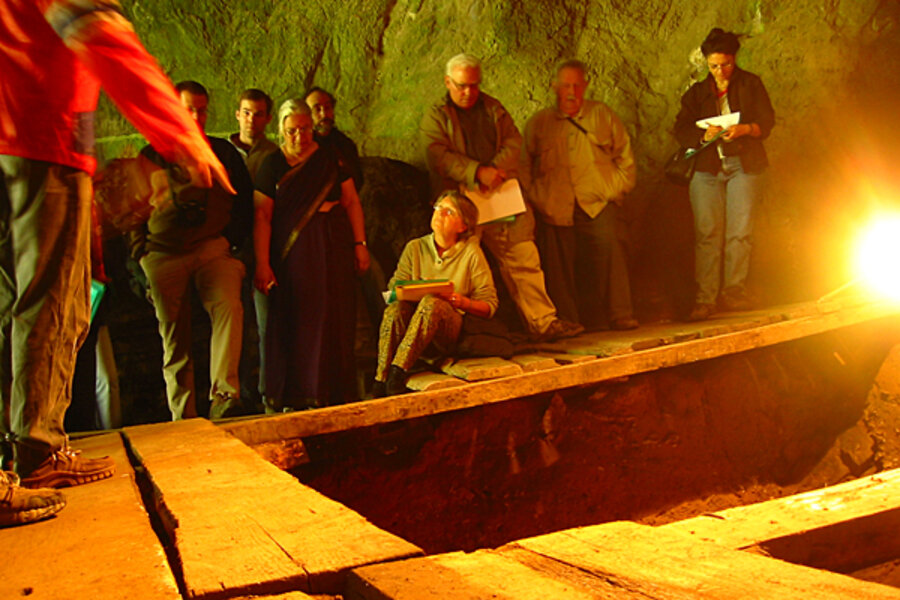X Woman: Not human, not Neanderthal, what is she?
Loading...
A mystery female known as X Woman may add a new chapter to the story of human ancestors leaving Africa to inhabit much of the planet.
Genetic material from a pinkie bone discovered two years ago in Siberia is challenging scientists' understanding of when humans and their evolutionary brethren left Africa, and whether a distinct and previously unknown species might have existed.
Researchers estimate the age of the pinkie bone to be between 30,000 and 48,000 years old. At that time, Neanderthals and anatomically modern humans also lived in that region of Siberia, deep in the Altai Mountains.
But to the researchers' surprise, the bone's genetic signature contained many distinct features compared with those of the remains of Neanderthals or modern humans. Indeed, the team's DNA analysis suggested that the bone came from line of so-called hominins that last shared a common ancestor with Neanderthals and modern humans about 1 million years ago. The team dubbed this potential common ancestor X Woman.
By contrast, Neanderthals and modern humans last shared a common ancestor about 500,000 years ago, anthropologists say – making X Woman about twice as distant from humans on the evolutionary tree as from Neanderthals.
"This was absolutely amazing," says team member Svante Paabo, with the Max Planck Institute for Evolutionary Anthropology in Leipzig. Whoever this was that left "Africa 1 million years ago is some new creature that has not been on our radar screen so far."
Who is X Woman?
The findings raise questions about what, exactly, X Woman is. Moreover, it's not clear yet whether the pinkie's owner is a distinct species descended from that million-year-old lineage or whether it represents a hybrid whose ancestors had long since interbred with other hominins in the region.
They also throw into doubt the theory that hominins left Africa for Eurasia in three waves.
Up until this discovery, that was the widely accepted view, Dr. Paabo says. Homo erectus bailed out on the African continent roughly 2 million years ago. Ancestors of Neanderthals left between 500,000 and 300,000 years ago. And anatomically modern humans migrated north some 50,000 years ago.
"We now clearly see something coming out of Africa" between Homo erectus and ancestors of Neanderthals, Paabo says. "Now that we've seen this, perhaps we shouldn't be that surprised, in hindsight," given the relative ease with which hominins could move from northern Africa across the Middle East and into the rest of the world.
Still, other researchers say they are impressed with the results, which appear in tomorrow's issue of the journal Nature.
Though the lineage may not have remained in Siberia for a million years, some vestige of it still appears 50,000 years ago, when the area was populated with humans and Neanderthals as well. "The fact that you can find a million-year-old lineage in Siberia that dates to individuals alive about 50,000 years ago is really quite remarkable," says Theodore Schurr, a biological anthropologist at the University of Pennsylvania in Philadelphia.
A genetic treasure trove
The genetic material collected from the pinkie bone was mitochondrial DNA, which ordinarily is inherited only from mothers, researchers say. This type of DNA, found outside a cell's nucleus, is an evolutionary bonanza for anthropologists.
Mitochondrial DNA is present in larger quantities than nuclear DNA, which carries an organism's entire genetic blueprint. So it doesn't take a large sample of tissue or bone to perform the necessary analysis. Mitochondrial DNA also is simpler – forming only 37 out of a human's typical compliment of 20,000 to 25,000 genes. And because it doesn't recombine with male DNA, it tells a less garbled evolutionary story.
Mitochondrial DNA may be useful for tracking ancestry and as a biological clock for estimating the age of particular lineage, but the team acknowledges that it will take studies of nuclear DNA found in the pinkie bone to determine if the pinkie's owner represents a unique species.
What if it is a new species?
If it is a distinct species, it raises some interesting question, Paabo and other team members acknowledge. Successive migrations of humans and their ancestors into Europe appear to have led to one group replacing another. That does not appear to be the case in southern Siberia, especially if three lineages occupied the area at the same time, rather than two. What accounts for the difference?
Moreover, scientists at Denisova Cave, where the pinkie was unearthed, unearthed bracelets and other ornaments from the same layer in which they found the pinkie. "There are several elements in the layer that have been associated with modern humans," acknowledges Johannes Krause, who is the lead author on the Nature paper reporting the results.
It could be that material from higher layers somehow got mixed into the layer hosting the pinkie bone. But it also could indicate that the individual involved was somehow interacting with modern humans in the region.
"It's quite puzzling," Krause says.





